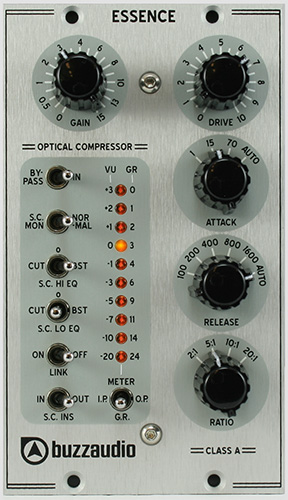
Buzz Audio's essence is a single-channel opto compressor module with many custom features usually found on larger, rack mounted compressors. One essence module fits into API's 500 Series rack — either the newer 4- or 6-slot Lunchboxes, or the 10-slot 500VPR unit. The unit occupies two slot spaces: Slot one's XLRs are for audio I/O; slot two's XLRs provide I/Os for a sidechain insert.
Like the Buzz Audio SOC 1.1 Stereo Optical Compressor (see the review in March 2004), the optical gain-change element uses a Hewlett-Packard Quad LED light block and four specially selected, light-dependent resistor elements. The light block is driven differentially so that two LDRs control the positive audio peaks and the other two control the negative. The main audio path uses Buzz's BE40 and BE50 discrete Class-A amps and Lundahl I/O transformers.
NOT A LIGHTWEIGHT UNIT
The densely packed front panel has a large 10-segment LED VU meter, seven toggle switches and five human-sized control knobs that are larger and feel better than the typical knobs used on API modules. Essence's operational precision is evident by the complete set of clearly marked front panel control knobs, including drive (threshold), ratio, output gain, attack and release.
There are switches for hardwire bypass, stereo or surround linking, sidechain insert I/O, sidechain monitor select, high- and/or lowpass filter insert to the sidechain path, and input/output/gain-reduction source select for the level VU meter. The VU can be internally set to read either standard +4 dBu or +14 dBu, with the latter better suited for use with a DAW.
The high- and lowpas sidechain filters have a "B" (boost) position and a "C" (cut) position. These are shelving filters with 8 dB of maximum boost/cut at 100 Hz and 10 kHz, with their corner frequencies both starting at 600 Hz, which is the classic Baxandall topology used in many EQ circuits.
A HARDWARE PLUG-IN
Essence went to work as soon as I plugged it into the studio's API rack. It went right in with no problems; you will have to secure it with screws so that the rear-edge connectors stay firmly seated. Essence pulls a total of 120 mA — 60 mA for each slot — which is well within spec for modern API racks.
My first tests were on individual drum tracks recorded flat into Pro Tools. Normally, I would not use an opto compressor on percussion because usually the attack times (if they are available) are too slow. Essence has a 1ms attack time that was actually too fast! At 1 ms with a 20:1 ratio and the drive control set halfway or higher, the snare hit's "stick" portion was completely removed. This type of special effect is usually associated with compressors that use VCAs or FETs.
The 15ms attack position was more realistic-sounding, producing a nice "pop" with each strike on the drum. Between the drive control setting and the excellent range of release times, you can dial in as much drum ring out as you want. I used the 200, 400 or 800ms positions, depending on tempo and whether the drummer played grace notes or fills between back beats.
On vocals, cleanliness is important, especially if you use a lot of compression. Essence's sound sparkles even using a 10:1 ratio and 10 dB or more of gain reduction. No compressor is transparent, but when I selected proper attack and release times, there were no noticeable bad-sounding artifacts. I used the "C" position on the sidechain's LPF to lessen the amount of compression caused by intermittent plosives and the subsonic low frequencies from my male singer.
Electric guitars sounded good when compressed by essence. I'm not generally into "auto" positions, but the auto-release time position worked fabulously on a funky rhythm guitar track. With the attack time set to 15 ms, there is very little dulling, even under about 6 dB of gain reduction. On guitars, primarily a midrange instrument, I used the "C" positions on both the low and high sidechain filters to narrow the frequency bandwidth available to essence's opto element. This setup produced a dense guitar sound without sounding overly clamped.
For bass guitars, I switched to the "B" mode in the sidechain's lowpass filter to make the unit more sensitive to low frequencies. The result was increased precision: You can fine-tune essence to exactly meet the needs of a bass guitar. Using a 2:1 ratio, 70ms attack and 800ms release, the ultraclean opto sound kept the Fender P bass sounding full and natural.
THE ESSENCE OF UTILITY
Essence packs a lot of easy-to-control power into just two API 500 slot spaces. At first, I had two immediate impressions: It is very clean-sounding and extremely fast for an opto-based compressor. I also liked the solid feel of the switches and knobs, along with the large VU meter that always indicates level and gain reduction, even in bypass. It functions cleanly for smooth and fast compression, making this $1,200 (MSRP) unit a first choice for any dynamic processing — from subtle to severe.
[2007]
Buzz Audio Ltd
Blenheim
New Zealand
Ph +64(0)3-577-5597
send us an email
